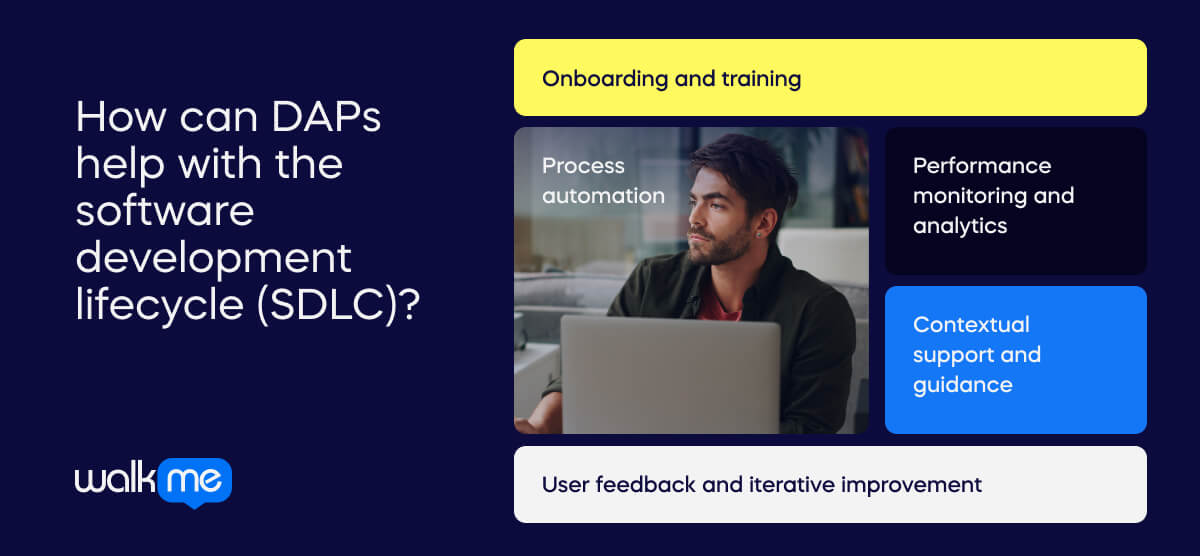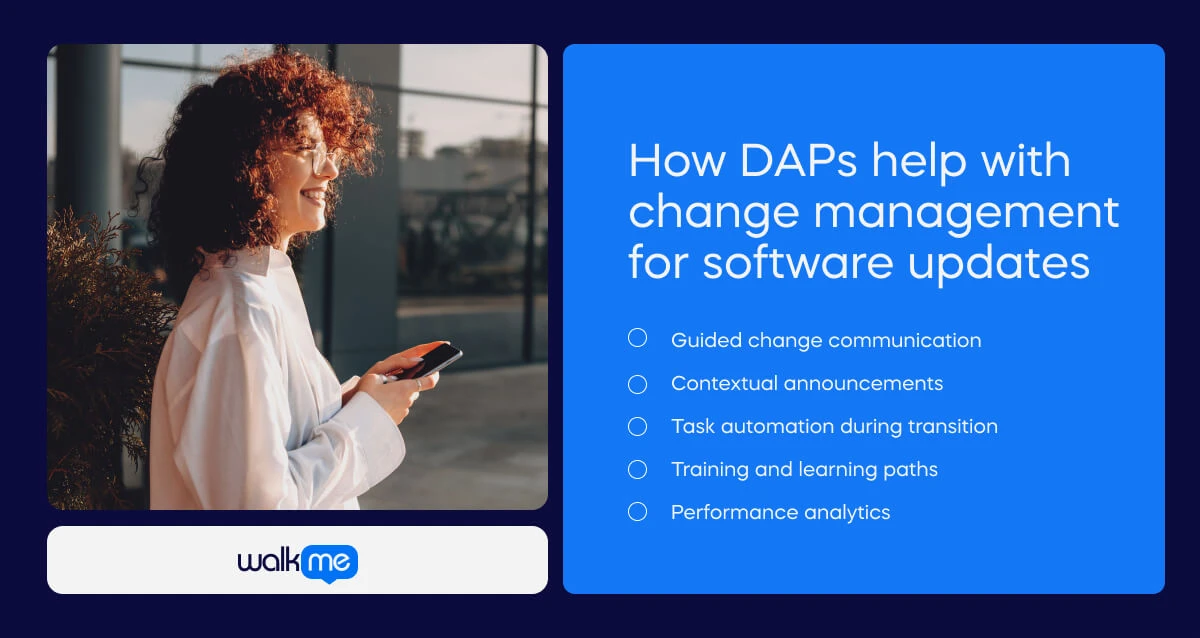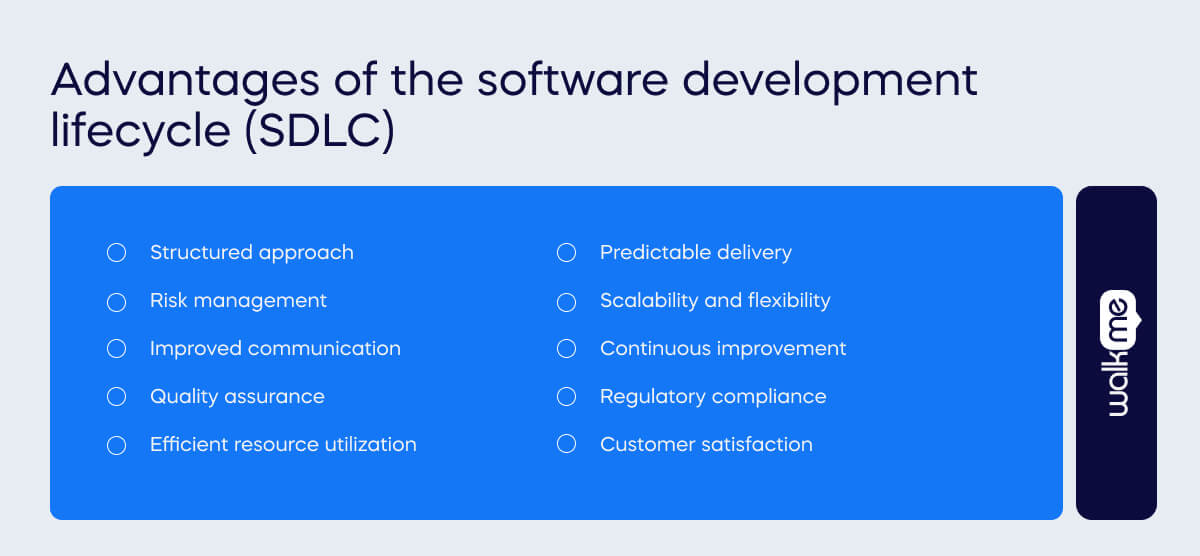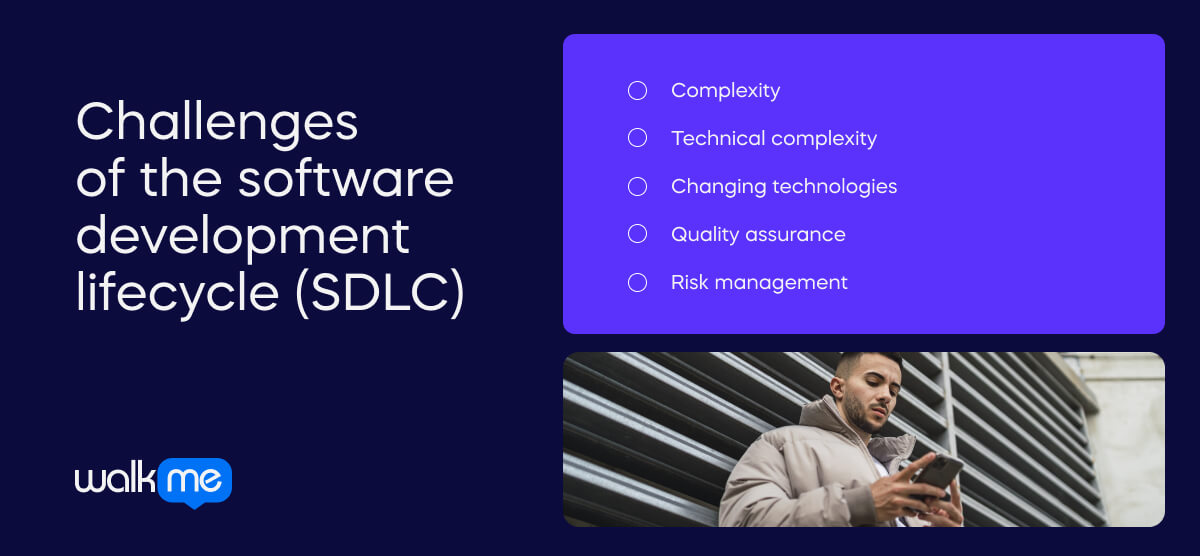What is the software development lifecycle (SDLC)?
The software development lifecycle (SDLC) is a framework that outlines the processes and phases involved in the development, maintenance, and eventual retirement of software applications. It provides a structured approach for software development teams to follow, ensuring that the software is built efficiently, meets quality standards, and satisfies customer requirements.

Table of contents
- What is the software development lifecycle (SDLC)?
- How can DAPs help with the software development lifecycle (SDLC)?
- Use cases for the software development lifecycle (SDLC)
- Advantages of the software development lifecycle (SDLC)
- Challenges of the software development lifecycle (SDLC)
- The future of the software development lifecycle (SDLC)
While there are various models of the SDLC, the typical stages include:
- Planning: Defining the scope, objectives, and requirements of the software project.
- Analysis: Analyzing the gathered requirements in detail to understand the functionalities and constraints of the software system.
- Design: Designing the software system’s architecture based on the requirements and analysis.
- Implementation (coding): Writing the code for the software application according to the design specifications.
- Testing: Testing the software to identify defects, errors, and inconsistencies.
- Deployment: Deploying the software application to the production environment or making it available to end-users.
- Maintenance: Maintaining and supporting the software after it has been deployed.
SDLC models, such as Waterfall, Agile, Spiral, and DevOps, offer different approaches to organizing these stages and managing the software development process.
How can DAPs help with the software development lifecycle (SDLC)?

A Digital Adoption Platform (DAP) like WalkMe can facilitate the software development lifecycle (SDLC) and support and enhance the process in several ways:
Onboarding and training
WalkMe provides interactive, step-by-step guidance for new team members during onboarding. This includes tutorials (Smart Walk-Thrus) and contextual help to familiarize them with software development tools, processes, and best practices. New developers can quickly learn to navigate the development environment, understand coding conventions, and follow established workflows.
Process automation
DAPs like WalkMe can automate repetitive tasks and workflows within the software development lifecycle (SDLC). For instance:
- Automating code reviews: WalkMe can guide developers through the code review process, ensuring adherence to coding standards and best practices.
- Streamlining testing procedures: WalkMe can automate test case execution, reducing manual effort and improving testing efficiency.
- Automating deployment processes: Developers can follow guided steps to deploy code changes seamlessly.
Workforces using DAPs like WalkMe to automate processes are ensuring they stay competitive in the digital space. Indeed, a report from Forrester indicates that the RPA (robotic process automation) software and services market will grow to $22 billion by 2025, meaning that there is increasing demand for using such automation in the workplace.
Performance monitoring and analytics
WalkMe allows organizations to track key performance indicators (KPIs) throughout the SDLC. Examples include:
- Development velocity: Measure how quickly features are developed and released.
- Defect rates: Monitor the frequency of defects and their impact on the development process.
- Team collaboration metrics: Assess collaboration effectiveness among team members.
Data-driven insights enable stakeholders to identify bottlenecks, optimize processes, and enhance overall productivity and quality.
Contextual support and guidance
Within the development environment (such as an IDE-integrated development environment or project management tool), WalkMe delivers context-sensitive support:
- Developers can access relevant documentation, code samples, and troubleshooting tips directly.
- This reduces the need to switch between different applications, improving efficiency.
User feedback and iterative improvement
WalkMe can facilitate a feedback loop by collecting input from users, stakeholders, and end customers throughout the SDLC. Teams can iterate quickly, address issues promptly, and continuously improve the software based on real-world usage and user needs.
How DAPs help with change management for software updates

DAPs can assist with change management efforts by guiding users through software updates, new features, and process changes as part of an SDLC. This helps minimize resistance to change and ensures smooth adoption of innovations within the development team. Here’s a more in-depth look at how WalkMe does it:
Guided change communication
WalkMe can create interactive guides that walk users through software updates, new features, and process changes. For example, when a new version of a development tool is released, WalkMe can provide step-by-step instructions on what has changed (ShoutOuts), how to adapt, and where to find relevant resources.
Contextual announcements
WalkMe can display context-sensitive announcements within the development environment. When users login or open a specific tool, WalkMe can notify them about upcoming changes, feature enhancements, or process updates.
Task automation during transition
During a transition (e.g., adopting a new development methodology), WalkMe can automate tasks in the following ways:
- Guided migration: Developers can follow recommended steps to transition from an old process to a new one.
- Automated data migration: WalkMe can assist in migrating data or configurations seamlessly.
Training and learning paths
WalkMe can create personalized learning paths (TeachMe) for developers during transitions. These paths include tutorials, quizzes, and assessments related to the changes. For instance, if the team adopts a new coding standard, WalkMe can guide developers through best practices.
Performance analytics
WalkMe tracks adoption metrics like the below:
- Feature usage: Monitor how frequently developers engage with new features.
- Completion rates: Assess if users successfully adapt to the changes.
- Time spent: Understand how long it takes for developers to adjust.
Use cases for the software development lifecycle (SDLC)
Software development lifecycle (SDLC) in business
Here are three examples of how the software development lifecycle (SDLC) can manifest in various business scenarios:
E-commerce platform development
A company wants to develop a new e-commerce platform to sell its products online. The SDLC stages might unfold as follows:
- Planning: The company defines the project’s scope, sets objectives, and gathers requirements from stakeholders, such as marketing, sales, and IT teams.
- Analysis: Business analysts analyze the gathered requirements, conduct market research, and create use cases and user stories to understand user needs and expectations.
- Design: Designers create wireframes, mockups, and prototypes of the e-commerce platform, defining the user interface, navigation flows, and system architecture.
- Implementation: Developers write the code for the platform, integrating features such as product catalogs, shopping carts, payment gateways, and user authentication.
- Testing: QA testers conduct various tests, including functional testing, usability testing, performance testing, and security testing, to ensure the platform meets quality standards.
- Deployment: The e-commerce platform is deployed to production servers, configured, and launched for customers.
- Maintenance: The company provides ongoing support, monitoring, and updates to the platform to fix bugs, add new features, and improve performance based on user feedback and market trends.
Mobile app development
Suppose a startup wants to develop a mobile app to provide users with a personalized fitness coaching experience. The SDLC stages might progress as follows:
- Planning: The startup defines the app’s target audience, features, and goals, aligning them with its business objectives and market demand.
- Analysis: Product managers gather user requirements through surveys, interviews, and competitor analysis, identifying key functionalities such as workout tracking, meal planning, and progress monitoring.
- Design: UX/UI designers create wireframes and visual designs for the app, focusing on intuitive navigation, engaging visuals, and seamless user experience across different devices.
- Implementation: Mobile app developers write the code for the app, integrating features such as GPS tracking, push notifications, and in-app purchases, following platform-specific guidelines for iOS and Android.
- Testing: Testers conduct usability, compatibility, and performance testing on various devices and operating systems to ensure the app functions correctly and delivers a smooth user experience.
- Deployment: The mobile app is submitted to the Apple App Store and Google Play Store, undergoes review processes and is eventually made available for download by users.
- Maintenance: The startup releases updates to the app regularly, addressing bugs, adding new features, and optimizing performance based on user feedback and usage analytics.
Enterprise resource planning (ERP) system implementation
A large corporation implements a new ERP system to streamline business processes and improve operational efficiency. The SDLC stages could look like this:
- Planning: The corporation defines its business requirements, objectives, and budget for the ERP implementation, involving key stakeholders from various departments such as finance, HR, and supply chain.
- Analysis: Business analysts thoroughly analyze existing business processes, data workflows, and system integrations to identify pain points and opportunities for improvement.
- Design: ERP consultants design the system architecture, data models, and workflow diagrams, customizing modules such as finance, procurement, inventory management, and human resources to meet the corporation’s specific needs.
- Implementation: ERP developers configure and customize the system according to the design specifications, migrating data from legacy systems and integrating with third-party applications and databases.
- Testing: Testers perform end-to-end testing, user acceptance testing, and data validation to ensure the ERP system meets functional requirements, regulatory compliance, and performance benchmarks.
- Deployment: The ERP system is deployed in phases or modules, with training sessions conducted for employees to learn how to use the new system effectively.
- Maintenance: The corporation provides ongoing support, monitoring, and optimization of the ERP system, addressing issues and implementing updates to adapt to evolving business needs and regulatory changes.
Software development lifecycle (SDLC) vs system development lifecycle
The terms software development lifecycle (SDLC) and system development lifecycle are often used interchangeably, but they can have distinct meanings depending on the context. While both terms involve the lifecycle of developing systems:
- Software development lifecycle (SDLC) specifically focuses on creating software applications.
- The system development lifecycle encompasses broader systems, including software and hardware, networks, processes, and organizational structures.
Here’s a breakdown of each:
| Software development lifecycle (SDLC) | System development lifecycle (SDLC) | |
| Scope | Focuses specifically on developing software applications | Encompasses the development of entire systems, including software, hardware, networks, processes, and organizational structures |
| Primary focus | Development, testing, deployment, and maintenance of software products | Development, integration, and operation of systems within an organization or environment |
| Typical models | Waterfall, Agile, Spiral, DevOps, etc | May incorporate elements from various methodologies, including systems engineering, project management, and software development methodologies |
| Interdisciplinary approach | Involves primarily software developers, testers, and related roles | Involves interdisciplinary teams, including software developers, systems engineers, business analysts, project managers, end-users, and other relevant stakeholders |
| Lifecycle components | Encompasses stages such as planning, analysis, design, implementation, testing, deployment, and maintenance of software | Encompasses the entire lifecycle of a system, including concept development, planning, design, implementation, operation, maintenance, and retirement/replacement |
| System components | Focuses primarily on software components and their integration | Considers integration with other system elements, such as hardware, networks, databases, processes, and organizational structures |
| Context | Often applied in the context of developing software applications for specific purposes, such as business, consumer, or enterprise use | Applied in various contexts, including developing complex systems, infrastructure projects, organizational transformations, and large-scale IT initiatives |
Advantages of the software development lifecycle (SDLC)

The software development lifecycle (SDLC) offers several advantages that contribute to software applications’ successful development, deployment, and maintenance.
Some of these advantages include:
Structured approach
SDLC provides a structured framework for software development with clearly defined stages and processes. This structure helps teams organize their work effectively, ensuring no critical steps are overlooked or skipped.
Risk management
By following a defined process, SDLC allows teams to identify and mitigate risks early in the development cycle. This proactive approach helps minimize the chances of project delays, cost overruns, and quality issues.
Improved communication
SDLC promotes communication and collaboration among team members, stakeholders, and end-users. Clear documentation, regular meetings, and feedback sessions facilitate a better understanding of requirements, expectations, and project status.
Quality assurance
SDLC includes built-in mechanisms for quality assurance, such as testing at each stage of development. This focus on quality helps identify and address defects early, resulting in higher-quality software products and improved user satisfaction.
Efficient resource utilization
SDLC helps teams allocate resources effectively by providing visibility into project timelines, dependencies, and resource requirements. This allows organizations to optimize resource allocation and minimize waste, leading to greater efficiency and cost savings.
Predictable delivery
SDLC enables teams to create realistic project plans and timelines based on historical data and past experiences. This predictability helps stakeholders manage expectations and plan for software releases with confidence.
Scalability and flexibility
SDLC can be adapted to suit the needs of different projects, teams, and organizations. Whether developing small-scale applications or large-scale enterprise systems, SDLC principles and practices can be scaled and customized accordingly.
Continuous improvement
SDLC encourages a culture of continuous improvement, with opportunities for reflection, evaluation, and refinement at each stage of the development process. This iterative approach enables teams to learn from their experiences and incorporate lessons learned into future projects.
Regulatory compliance
SDLC frameworks often include provisions for regulatory compliance, ensuring that software products meet industry standards, legal requirements, and security guidelines. This helps organizations avoid legal issues and reputational damage associated with non-compliance.
Customer satisfaction
Ultimately, SDLC aims to deliver software products that meet or exceed customer expectations. By focusing on quality, communication, and user feedback, SDLC helps ensure that software applications are aligned with user needs and preferences, leading to greater customer satisfaction and loyalty.
Challenges of the software development lifecycle (SDLC)

While the software development lifecycle (SDLC) offers numerous advantages, it also presents several challenges that development teams may encounter. Some of these challenges include:
Complexity
SDLC involves multiple stages, processes, and stakeholders, which can make it inherently complex. Managing dependencies, coordinating activities across teams, and ensuring alignment with project objectives can be challenging, particularly in large-scale projects.
Technical complexity
Developing software solutions with advanced functionalities or integrating with complex systems can introduce technical challenges. Dealing with technical debt, managing legacy systems, and addressing compatibility issues across platforms and environments require specialized expertise and careful consideration.
Changing technologies
Rapid technological advancements and evolving industry trends can challenge software development teams. Keeping up with new technologies, tools, and methodologies requires ongoing learning and adaptation, which can strain resources and disrupt established workflows.
Quality assurance
Ensuring software quality throughout the SDLC can be challenging, particularly in complex projects with tight deadlines. Balancing the need for thorough testing with project timelines, identifying and resolving defects promptly, and maintaining product quality in the face of changing requirements are ongoing challenges for development teams.
Risk management
Identifying, assessing, and mitigating risks is integral to the SDLC, but it can be challenging to anticipate and address all potential risks effectively. Uncertainty, unforeseen events, and external factors beyond the team’s control can impact project outcomes and require proactive risk management strategies.
The future of the software development lifecycle (SDLC)
The software development lifecycle (SDLC) is a structured approach to software development that encompasses various stages, from planning and analysis to deployment and maintenance. We’ve explored its definition, relevance in business contexts, comparison with the system development lifecycle, and advantages and challenges. SDLC is critical in ensuring software development is clearly defined with a structured framework while improving communication and quality assurance. However, it’s not without its complexities and hurdles, from managing rapid technological advancements to assessing and mitigating risks effectively.
The future of SDLC is poised for further evolution, particularly with the integration of Digital Adoption Platforms (DAPs) like WalkMe. This software offers promising solutions to streamline the SDLC process by providing intuitive user interfaces, interactive guidance, and analytics-driven insights. By leveraging DAPs, organizations can enhance collaboration, accelerate time-to-market, and improve overall software quality. Indeed, AI will likely become a stronger influence on the process automation DAPs can use to facilitate tasks such as code reviews and deployment processes with the SDLC.
Research from Mordor Intelligence reveals that the Enterprise AI market is projected to reach an impressive $204.79 billion by 2029, indicating a likelihood that SaaS companies like DAPs will look into integrating AI more heavily with process automation. As technology advances and businesses strive for greater efficiency and agility, the synergy between SDLC and DAPs presents exciting opportunities for innovation and growth in software development.